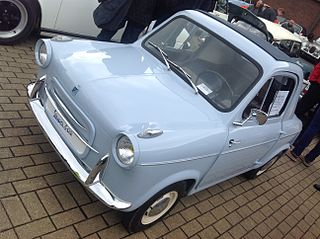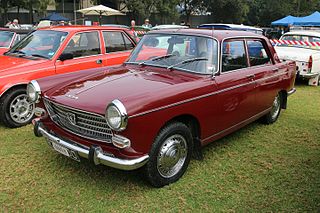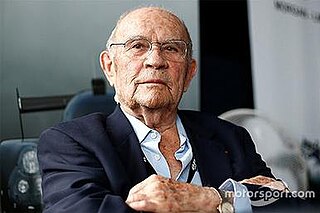
Ligier is a French automobile and minibus maker created by former racing driver and rugby player Guy Ligier (1930–2015), specialized in the manufacturing of microcars. Ligier is best known for its involvement in the Formula 1 World Championship between 1976 and 1996.

The Vespa 400 is a rear-engined microcar, produced by ACMA in Fourchambault, France, from 1957 until 1961 to the designs of the Italian Piaggio company. Three different versions were sold, the "Luxe", "Tourisme" and "GT".

The Peugeot 504 is a mid-size, front-engine, rear-wheel-drive automobile manufactured and marketed by Peugeot from 1968 to 1983 over a single generation, primarily in four-door sedan and wagon configurations – but also as twin two-door coupé and cabriolet configurations as well as pickup truck variants.

Unic was a French manufacturer founded in 1905, and active as an automobile producer until July 1938. After this the company continued to produce commercial vehicles, retaining its independence for a further fourteen years before being purchased in 1952 by Henri Pigozzi, who was keen to develop Unic as a commercial vehicle arm of the then flourishing Simca business.
Microcar is a French microcar manufacturer. The company was founded in 1984 as a division of Bénéteau group, a major sailboat manufacturer. Production moved to a new custom-built factory in September 2000. In September 2008, Microcar was acquired by Ligier Automobiles in a deal backed by the Italian private equity firm 21 Investimenti Partners. The merger created Europe's second-biggest manufacturer of microcars, and largest maker of quadricycles, or "sans permis" (license-exempt) vehicles. The Microcar and Ligier brands are to retain their separate identities and production facilities. Phillipe Ligier, son of company founder Guy Ligier, is CEO of the expanded Ligier Automobiles.
Berliet was a French manufacturer of automobiles, buses, trucks and military vehicles among other vehicles based in Vénissieux, outside of Lyon, France. Founded in 1899, and apart from a five-year period from 1944 to 1949 when it was put into 'administration sequestre' it was in private ownership until 1967 when it then became part of Citroën, and subsequently acquired by Renault in 1974 and merged with Saviem into a new Renault Trucks company in 1978. The Berliet marque was phased out by 1980.

Aixam-Mega is a French automobile manufacturer based in Aix-les-Bains, Savoie. It was founded in 1983 to make microcars following the acquisition of Arola. On 11 April 2013, US based Polaris Industries announced that it had acquired Aixam-Mega from previous owners Axa Private Equity.

The Peugeot 404 is a large family car produced by French automobile manufacturer Peugeot from 1960 to 1975. A truck body style variant was marketed until 1988. Styled by Pininfarina, the 404 was offered initially as a saloon, estate, and pickup. A convertible was added in 1962, and a coupé in 1963. The 404 was fitted with a 1.6 litre petrol engine, with either a Solex carburetor or Kugelfischer mechanical fuel injection or a 1.9 litre diesel engine available as options. Introduced at the Paris Motor Show as an option was the inclusion of a 3-speed ZF automatic transmission, similar to the unit already offered on certain BMW models, as an alternative to the standard column-mounted manual unit.

Guy Camille Ligier was a French racing driver and team owner. He maintained many varied and successful careers over the course of his life, including rugby player, butcher, racing driver and Formula One team owner.

The Peugeot 403 is a mid-size car manufactured and marketed by Peugeot between May 1955 and October 1966. A total of 1,214,121 of all types, including commercial models, were produced, making it the first Peugeot to exceed one million in sales.

The Toyota Hilux; stylized as HiLux and historically as Hi-Lux, is a series of pickup trucks produced and marketed by the Japanese automobile manufacturer Toyota. The majority of these vehicles are sold as pickup truck or cab chassis variants, although they could be configured in a variety of body styles.
The SD engine was replaced by the Nissan TD engine. It was manufactured by Minsei Diesel Industries, Ltd., which was renamed Nissan Diesel Motor Co., Ltd in 1960.
Rovin was a French auto-maker established in the Paris region, and most active from 1946 until 1959, although after 1953 production slowed to a trickle. The firm was established, initially as a motor-cycle business, in 1921 by the racing driver and motorcycle constructor, Raoul Pegulu, Marquis of Rovin. The car was developed by Raoul but in 1946 production became the responsibility of his brother, Robert who continued to run the business after Raoul's death.

The Isuzu Faster is a pickup truck that was manufactured and marketed by Isuzu between 1972 and 2002 over three generations. The Faster was succeeded worldwide by Isuzu D-Max, except in North America.

The Peugeot 402 is a large family car produced in Sochaux, France from 1935 to 1942 by Peugeot. It was unveiled at the Paris Motor Show in 1935, replacing the Peugeot 401.
The quadricycle is a European Union vehicle category for four-wheeled microcars, which allows these vehicles to be designed to less stringent requirements when compared to regular cars. Quadricycles are defined by limitations in terms of weight, engine power and speed.

The Ligier JS2 is a mid-engined sports coupé that was built by Ligier in the French commune of Abrest near Vichy in the department of Allier between 1971 and 1975. Road-going and competition versions were built.
The Ligier JS1 is a sports-racing car that debuted in 1969 and was built by Automobiles Ligier. The car competed in various sportscar racing events during the 1969 and 1970 seasons.

The Ligier Optima is a four-wheeled, four-seater microcar manufactured from 1987 to about 1995 by Ligier, the street vehicle branch of French Formula One manufacturer Equipe Ligier. It was originally introduced as the Ligier Série 7, but the name was changed to Optima in 1989. It replaced the earlier Série 5, the final development of a series of cars which started with the boxy Ligier JS4. Commonly, Optimas are "Voiture sans permis", light vehicles which do not require a driver's license and thus popular with the elderly, the young, or with those who had lost their driving privileges. Ligier also offered more powerful versions which could be driven with certain limited driver's permits and with very low anuual taxes. Versions for export markets often had slightly different engine outputs to meet local requirements.














